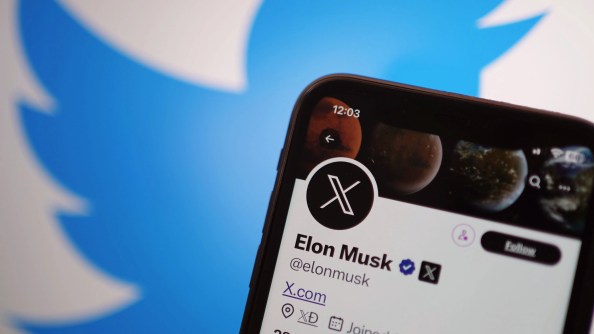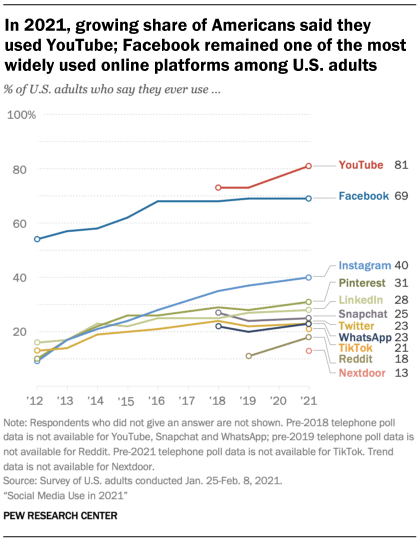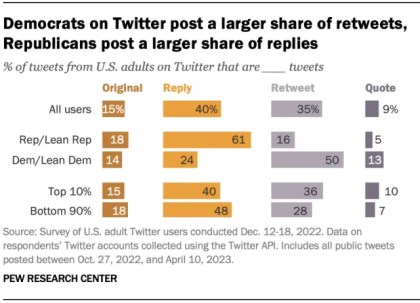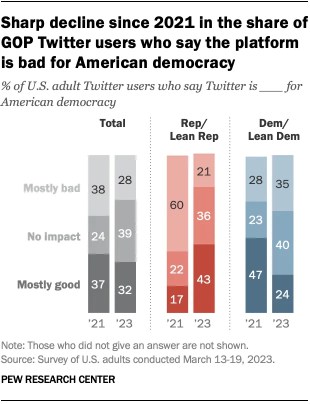
Twitter has seen big changes since Elon Musk purchased the company in October 2022. The social media platform has gone through a transition period marked by the exit of top executives, companywide firings and layoffs, and algorithms and policy overhauls. Most recently, Musk has rebranded the platform from Twitter to X.
Through these and other changes, millions of Americans continue to use Twitter. Here are eight facts about Americans’ use of the platform, based on Pew Research Center studies.
Pew Research Center conducted this analysis to show how Americans use Twitter, including since Elon Musk acquired the platform. All findings are based on Center surveys and analyses. Additional information about these studies and their methodologies are available in the links throughout this post.
In early 2021, 23% of U.S. adults said they use Twitter. The share of Americans using the platform remained steady over several years and was similar to the shares using Snapchat (25%) and WhatsApp (23%). But much larger shares of U.S. adults said they used YouTube (81%), Facebook (69%) and Instagram (40%).

Democrats were more likely than Republicans to use Twitter in 2021. About a third of Democrats and Democratic-leaning independents (32%) reported using Twitter as of early 2021, compared with 17% of Republicans and Republican leaners.
In a spring 2023 survey, 60% of U.S. adults who had used Twitter in the past year said they’d taken a break from the platform in that time. The survey was fielded about five months after Musk’s purchase of Twitter.
Among those who had used Twitter in the 12 months before the survey, women were more likely than men to say they’d taken a break from the platform (69% vs. 54%). And Black users (67%) were more likely than their White (60%) or Hispanic (54%) counterparts to say the same. (There were not enough Asian American Twitter users in the sample to analyze separately.)
In the same 2023 survey, a quarter of current or recent Twitter users said it is unlikely they will be on the site a year later. A plurality (40%) said they were extremely or very likely to use the site in a year, and 35% said they were somewhat likely to use it. But 25% said they were not very or not at all likely to be on Twitter a year from the time of the survey.
Larger shares of Democratic than Republican users said it was unlikely they will be on Twitter in a year (29% vs. 20%). Conversely, Republican Twitter users were more likely than Democratic ones to say they were likely to use the site a year from the time of the survey (45% vs. 36%).
Following Musk’s acquisition of Twitter, most highly active users continued to use the platform but posted less frequently, on average, according to a Center analysis of public tweets posted between January 2022 and April 2023. The analysis defined the most active users as the top 20% by tweet volume. These users’ average number of tweets per month declined by around 25% following Musk’s purchase of the site.
Despite the decline in tweet volume, eight-in-ten of the most active adult Twitter users between January and April 2022 remained among the most active users after Musk acquired the site that October.
The vast majority of tweets are replies or retweets, according to an analysis of tweets posted by U.S. adult users between October 2022 and April 2023. Three-quarters of these tweets were either replies to other users (40%) or retweets (35%). The rest were original tweets (15%) or quote tweets (9%).

Breaking down Twitter users by partisanship revealed differences in the types of tweets users post.
Democratic Twitter users were far more likely than their Republican counterparts to post retweets, while Republicans were much more likely than Democrats to post replies.
Over the past two years, Democratic and Republican Twitter users’ views of the site’s impact on American democracy have changed. Republican users have become much less likely to say the site is mostly bad for democracy (60% in 2021 vs. 21% now). In turn, the share of Republican users who say the platform is mostly good for American democracy increased from 17% in 2021 to 43% in 2023.

Democratic Twitter users’ views have moved in the opposite direction. In two years, the share of Democratic users who said the site is mostly good for American democracy decreased from 47% to 24%. The increase in the share who say it is bad for democracy was more modest, rising from 28% to 35%.
Partisan Twitter users have grown further apart in their views about misinformation, harassment and civility on the platform. As of March 2023, Democratic Twitter users were far more likely than Republican users to say inaccurate or misleading information is a major problem on the site (68% vs. 37%).

Democratic users were also more likely than Republican ones to say harassment and abuse from other users (65% vs. 29%) and the tone and civility of discussions (50% vs. 27%) were major problems.
After Musk acquired the platform, he reinstated several accounts that were banned for violating Twitter’s rules on hate speech or misinformation and disbanded the team tasked with addressing those problems. He also changed the way the site’s verification system works.
Between 2021 and 2023, there were notable increases in the shares of Democratic users who said Twitter limiting the visibility of certain posts (17% in 2021 to 32% in 2023) and banning users from the platform (6% to 19%) were major problems.
Meanwhile, the share of Republicans who said banning users from the platform was a major problem decreased. (The share of Republican users who said that post visibility is a major problem on the platform is statistically unchanged.)
Note: This is an update of a post originally published on Aug. 2, 2019, written by Adam Hughes and Stefan Wojcik. It was last updated May 5, 2022.
